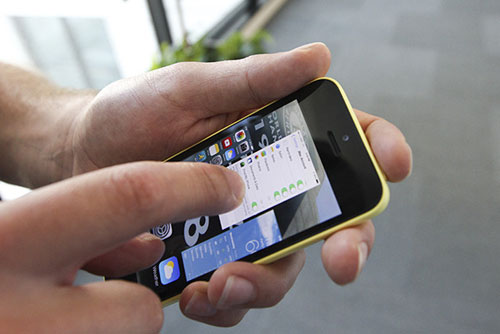You may not think of your smartphone as a computer, but it’s just as much of one as a laptop or desktop. With it come some very typical computer problems—crashes and freezes. A lot of the time, the fixes to these sorts of issues, while simple, aren’t immediately obvious. The next time your iOS or Android phone crashes or freezes, try these tips.
Dealing with a stuck iPhone
Force-close a frozen app: If one app in particular is causing you problems, try force-closing it. To do this on iOS 7, double-tap the Home button to bring up the app switcher, which Apple calls the multitask bar. Next, scroll left or right unti you can see the frozen app, and swipe up on the screenshot of the app to “fling” it off your screen. If you’re using iOS 6, tap the Home button to get to the home screen, then double-tap the Home button to bring up the app switcher. Next, hold your finger down on an app icon for a couple seconds until the icons start wiggling, then tap the red minus (-) button for the app you want to close.
Restart your phone: If your iPhone is acting wonky in general, or you can’t even open the app switcher to kill a frozen app, try restarting it. Hold down the Sleep button on the top of your phone until the red “slide to power off” slider appears. Slide your finger from left to right as instructed, and your phone will power down. To turn your phone back on, hold the Sleep button for a few seconds until you see the Apple logo on your screen. It will take a minute before your phone finishes booting up and is ready to use.
Force-restart your phone: If your phone isn’t responding to your taps or button presses, you may need to force it to restart. Hold down the Sleep button and the Home button for a few seconds until the Apple logo appears, and your phone will restart. After a few moments, it will take you to the lock screen and be up and running as usual.
Reset to factory defaults: If you have a nagging issue with your phone that won’t go away readily—or if you want a fresh start—you can try reverting your iPhone to factory default settings. To do so, go to the Settings app, then go to General > Reset and select Reset All Settings. This option will reset your phone’s settings, but it will preserve any data you have on your phone. If you want to clear off your phone completely and start fresh, select Erase All Content and Settings for that new-out-of-the-box experience.
Restore using iTunes: You can also try restoring your iPhone via iTunes. Plug your iPhone into your computer using your USB cable, and select your iPhone from the source list. Go to the Summary tab, and then select Restore iPhone: This will create a backup of your phone’s settings, and then download and install a fresh copy of iOS and revert your phone to default settings. You can then put your data back on your phone by selecting Restore Backup from under the Backups heading.

Dealing with a stuck Android phone
Force-close an app: If you need to force a hung app to close, go to your phone’s Settings app, then tap Apps. Swipe over to the Running tab, select the app you want to close, then tap the Stop button. If you don’t see the troublesome app in the list, tap the Show Cached Processes toggle in the upper-right corner of the screen.
Restart your phone: Restarting your phone can help clear up stubborn problems. To do so, hold down your phone’s sleep/power button for a few seconds until it asks you if you really want to turn off your phone. Confirm that you do, and your phone will power off. Once it’s off, hold down the power button again until the screen turns on; your phone should be up and running again after a few moments.
Force-restart your phone: The standard shut-down-and-restart method may not work if your phone is frozen, in which case you may have to force your phone to restart. Unfortunately, it’s a little more complicated on Android than it is on iOS, because different phones may have different hard-restart methods. You can force many Android phones to shut down, however, by holding down the power button and volume-up button until the screen goes dark. From there, power on your phone again by pressing the power button for a few seconds. If the volume-up button doesn’t work, try the volume-down button. If this doesn’t work, refer to your phone’s documentation.
Remove the battery: If your Android phone is frozen solid and it has a removable battery, the easiest way to force-restart it is to simply remove the battery. Pop off the battery cover, remove the battery for a few seconds, put it back into place, snap the battery cover back on, then turn your phone back on by holding the power button down for a few seconds. You should use this method only if the standard method of powering off and restarting your phone fails, however.
Restore to factory defaults: Maybe you decided that trying to troubleshoot an issue just isn’t worth the hassle. If so, you can reset your phone entirely and restore it to factory defaults. To do so, open your phone’s Settings app, scroll down, and tap the Backup and Reset menu. Next, look for Factory data reset, and tap it. Your phone will ask you to confirm that you want to do the deed; once you do, it will restore itself to pristine, fresh-from-the-factory settings.
Source: www.techive.com


